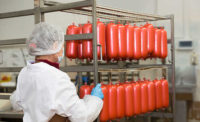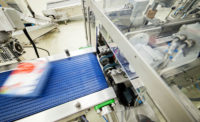Conveyors and beltings are key hotspots in the push by meat and poultry processors to eradicate pathogens in their plants.
Keeping the equipment free of bacteria is crucial for enhancing food safety and is leading to technology developers and processors putting greater focus on machine designs and cleaning techniques likely to reduce the threat of pathogens.
“It is important to recognize conveyors as a potential contamination source,” says Martin Bucknavage, senior food safety extension associate in the Department of Food Science at Penn State University in University Park. “Choosing a conveyance system that is easy to clean and resists buildup of pathogens is critical.”
Such technologies can feature continuous cleaning systems, which perpetually spray wash areas of the conveyor that are likely to be bacteria harbingers, he says.
It also is crucial for processors to select conveyors in accordance with the type of proteins the equipment will be handling, Bucknavage says. That includes designs that can better support meats that drip more often or are likely to stick to conveyors, he says, adding that “product characteristics must be taken into account.”
Of particular concern are conveyor rollers and frames, which are frequent sites of pathogens, says Norman Marriott, emeritus professor in the College of Agriculture and Life Sciences at Virginia Polytechnic Institute and State University (Virginia Tech) in Blacksburg. The equipment should be easy to access for cleaning and contain elements that better prevent food particles from accumulating, he says.
Marriott says machine manufacturers are giving greater emphasis to sanitation by eliminating holes and pockets where food can collect; making conveyors simpler to disassemble for sanitizing; and incorporating rounder edges on designs, which are less likely to capture food particles and are easier to clean than square edges.
The smoothness of the conveyor also can affect sanitation. Stainless steel designs are better at preventing meat trimmings from clinging and more durable, he says.
A high price to pay
In addition to leveraging robust machinery, training employees on the best sanitizing techniques and taking frequent microbial samplings from equipment will also enable processors to better control pathogens, Marriott says.
“Companies cannot afford the cost and bad reputation that results from product recalls,” he says. “It is important for processors to continually test both the conveyors and meat products for micro-organisms.”
Processors should sanitize the large surface areas underneath conveyors to further prevent pathogens from forming, says Guy Loushin, safety consultant for Allen Safety, a Merritt Island, Fla.-based global safety and process improvement company.
Other potential sources of pathogens are the flites on conveyor belts, which may develop hairline cracks during normal operations and have food lodge in the crevices, Loushin says. He adds such areas are extremely difficult to clean and typically require belt replacement.
Mesh belts, meanwhile, also are likely to harbor bacteria, he says, adding that some operators are eliminating the equipment while others are installing spray bars and clean-in-place systems to reach hard-to-sanitize locations.
Loushin says sanitation personnel should routinely inspect belts for defects, and that hand scrubbing and running the belts after applying foam cleaning agents so that the agents penetrate all nooks will provide superior results.
A well-thought-out floor plan for cleaning each production area, meanwhile, is critical for preventing over-spraying and the subsequent need to re-clean equipment, he says.
“Many locations have multiple conveyors close together in parallel running the length of the processing floors,” Loushin says. “Teams that do not coordinate their cleaning efforts may inadvertently spray debris onto a clean conveyor while they are sanitizing a nearby device.”
Put worker safety in the spotlight
As they develop systems for cleaning conveyors and beltings, it is vital that operators also address worker safety as sanitizing teams — particularly those cleaning elevated equipment — face health risks, Loushin says.
“The lack of elevated platforms or adequate fall protection anchor points or cable systems make cleaning those conveyors difficult, and they place sanitation workers at danger to injury from height falls.”
He adds, however, that more processors are eliminating or greatly reducing their use of overhead conveyors, as sanitation employees are safer and more efficient when not working on ladders or above the floor.
Processors also can reduce injury risks by turning off unattended adjacent conveyors during equipment cleanings, Loushin says.
He says that because conveyor cleanings often occur with belts moving, guarding the shaft and shaft ends properly is essential for protecting workers.
“Sanitation employees standing on ladders when cleaning conveyors seven feet above the floor may still face exposure to shafts and shaft ends that can catch on their personal protective equipment” and pull them into the machinery, Loushin says.
In addition, operators can make the cleaning process safer and more efficient by providing easy access to the lockout/tagout disconnects that quickly disable conveyors so that workers can lift and sanitize belts, he says.
“It is hard for workers to reach disconnects that are high up on the equipment and require a ladder to access or are out of the line of sight of the employees cleaning the conveyors,” Loushin says.
Efficient designs also make it simpler for workers to replace motors and other conveyor parts that require changing on a regular basis, while enabling sanitation teams to safely clean devices in less time with fewer employees, he says.
“Conveyors and belts are constantly improving and making cleaning and equipment repair easier,” Loushin says.
Always be vigilant
Yet, even with improvements to conveyors and sanitizing techniques, processors must ensure employee mishaps are kept to a minimum if they are to achieve optimal efficiencies.
Schweid & Sons, a Carlstadt, N.J.-based ground beef purveyor with plants in Carlstadt and College Park, Ga., uses proprietary conveyor designs to divert 1,500- to 2,000-pound batches of grinds into forming devices for the creation of burgers. The company follows a sanitizing program that includes daily wash downs and nightly belt cleanings, says Jamie Schweid, president and chief executive officer.
Complications can arise during the sanitizing stage when plant personnel move conveyors from processing locations to areas of the plant that have the necessary work space for easy access to the equipment, he says. It can be challenging, Schweid notes, to ensure the workers return the machines to the precise spots after cleaning.
Conveyors that do not properly align with forming equipment can alter the flow of meat and cause product to fall to the ground, creating waste, Schweid says. NP










